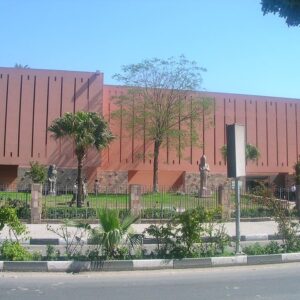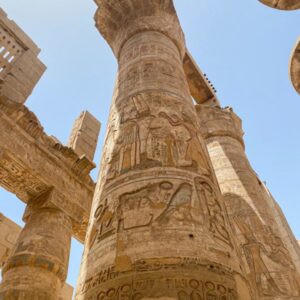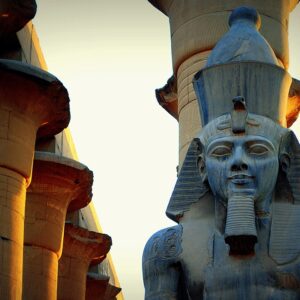
About
The Temple of Luxor (Arabic: معبد الأقصر) is a large ancient Egyptian temple complex on the east bank of the Nile in the city now known as Luxor (ancient Thebes), and was built around 12.1400 BC. C. In the Egyptian language it was known as ipet resyt, «the sanctuary of the south». It was one of the two main temples on the east bank, the other being Karnak. Unlike the other temples in Thebes, the Luxor Temple is not dedicated to any cult god or deified god. version of the pharaoh in death. Instead, Luxor Temple is dedicated to the rejuvenation of royalty; It may have been the site where many of the Egyptian pharaohs were actually or conceptually crowned (as in the case of Alexander the Great of
who claimed he was crowned at Luxor but never went south to Memphis near modern Traveled to Cairo).
At the back of the temple are chapels built by Amenhotep III. 18th Dynasty and built by Alexander. Other parts of the temple were built by Tutankhamun and Ramses II. During Roman times, the temple and its surroundings were a legionary stronghold and the seat of Roman government in the region. During Roman times, a chapel in Luxor Temple originally dedicated to the goddess Mut was converted into a cult chapel of the Tetrarchy and later into a church. Along with the other archaeological sites in Thebes, the Luxor Temple was inscribed on the UNESCO World Heritage List in 1979.
Excavation
Since the Middle Ages, the Muslim population of Luxor had settled in and around the temple at the southern end of the mountain. For centuries, due to the construction of the population of Luxor city on and around Luxor Temple, debris had accumulated to the point where an artificial mound about 14.5 to 15 meters (48 to 49 feet) high stood, Professor Gaston Maspero had begun excavating the Luxor Temple after 1884, having received permission to begin work. Excavations were carried out sporadically until 1960. Over time, the accumulated debris of the centuries had buried three quarters of the temple, which contained the courtyards and colonnades that formed the nucleus of the Arab half of the modern city.
Maspero had previously been interested and took over from Mariette Pascha in 1881 to complete the work. There was not only rubbish, but also barracks, shops, houses, shacks, dovecotes that had to be removed in order to excavate the site. (A working mosque still exists within the temple and was never removed.) Maspero received the necessary approval from the Egyptian Minister of Public Works to raise funds to negotiate compensation for the lands occupied by the houses and outbuildings.
Festivals
Luxor Temple was built during the New Kingdom and was dedicated to the Theban triad of Amun, his wife Mut and their son Khonsu. Nile from the nearby Karnak Temple (ipet-sut), staying there for some time with his consort courage was supposed to promote the fertility of Amun-Re and Pharaoh.
You Can View Our Luxor Tours NowStations Avenue of Sphinxes and Shrine
The avenue (known as wi.t ntr «God’s way»; طريق الكباش) that ran some 2,700 meters (8,900 ft) in a straight line between Luxor Temple and the Karnak area was lined with human-headed sphinxes; in antiquity these probably replaced earlier sphinxes, which may have had different heads] Six boat sanctuaries, serving as stopovers for the boats of the gods during festive processions, were erected on the avenue between Karnak and the Temple of Luxor along which avenue stations were used for ceremonies such as set up the Opet festival, which is important for the temple. Each station had a purpose, for example the fourth station was the station of Kamare which refreshed
Amun’s oar.
Abu El_Haggag Mosque
The active Abu Haggag Mosque (مسجد أبو الحجاج بالأقصر) is located inside the temple and stands on ancient pillars. This part of the Luxor Temple was converted into a church and later into a mosque by the Romans in 395 AD. in the year 640, which equates to more than 3,400 years of uninterrupted religious worship, making the Luxor Temple the oldest building in the world used at least in part for purposes other than archaeological or tourist purposes.
-
 Visita guiada al Museo de Luxor y al Museo de la Momificación0.00 € – 47.00 €
Visita guiada al Museo de Luxor y al Museo de la Momificación0.00 € – 47.00 € -
 Templo de Karnak y Luxor en una visita guiada0.00 € – 55.00 €
Templo de Karnak y Luxor en una visita guiada0.00 € – 55.00 € -
 Tour guiado por el valle oriental y occidental del Nilo0.00 € – 100.00 €
Tour guiado por el valle oriental y occidental del Nilo0.00 € – 100.00 €






